| Article ID | Journal | Published Year | Pages | File Type |
|---|---|---|---|---|
| 7973480 | Materials Science and Engineering: A | 2018 | 19 Pages |
Abstract
Incremental step load (ISL) technique was used to determine the material susceptibility of three different grades of tempered martensite steels 35CrMo4, 41Cr4 and 36NiCrMo4 to hydrogen embrittlement (HE). In addition to testing the steel grades in air, the environmental hydrogen embrittlement susceptibilities (EHE) of each material were determined by in-situ charging of hydrogen at three different cathodic potentials â0.85 VSCE, â1VSCE and â1.2VSCE to obtain the entire threshold curves for these materials. Overall investigation implies that 35CrMo4 is more susceptible than 41Cr4 and 36NiCrMo4. The fracture surface morphology in case of 35CrMo4 is entirely intergranular at â1VSCE and â1.2VSCE showing the severity of embrittlement. The higher matrix-cementite interfaces along with high cementite and low manganese sulphide (MnS) inclusion content of 36NiCrMo4 influencing the hydrogen transport kinetics within the material are responsible for the lower material susceptibility. The thermal desorption analyses (TDA) further corroborate the observations.
Related Topics
Physical Sciences and Engineering
Materials Science
Materials Science (General)
Authors
Tuhin Das, Sriraman K. Rajagopalan, Salim V. Brahimi, Xiang Wang, Stephen Yue,
